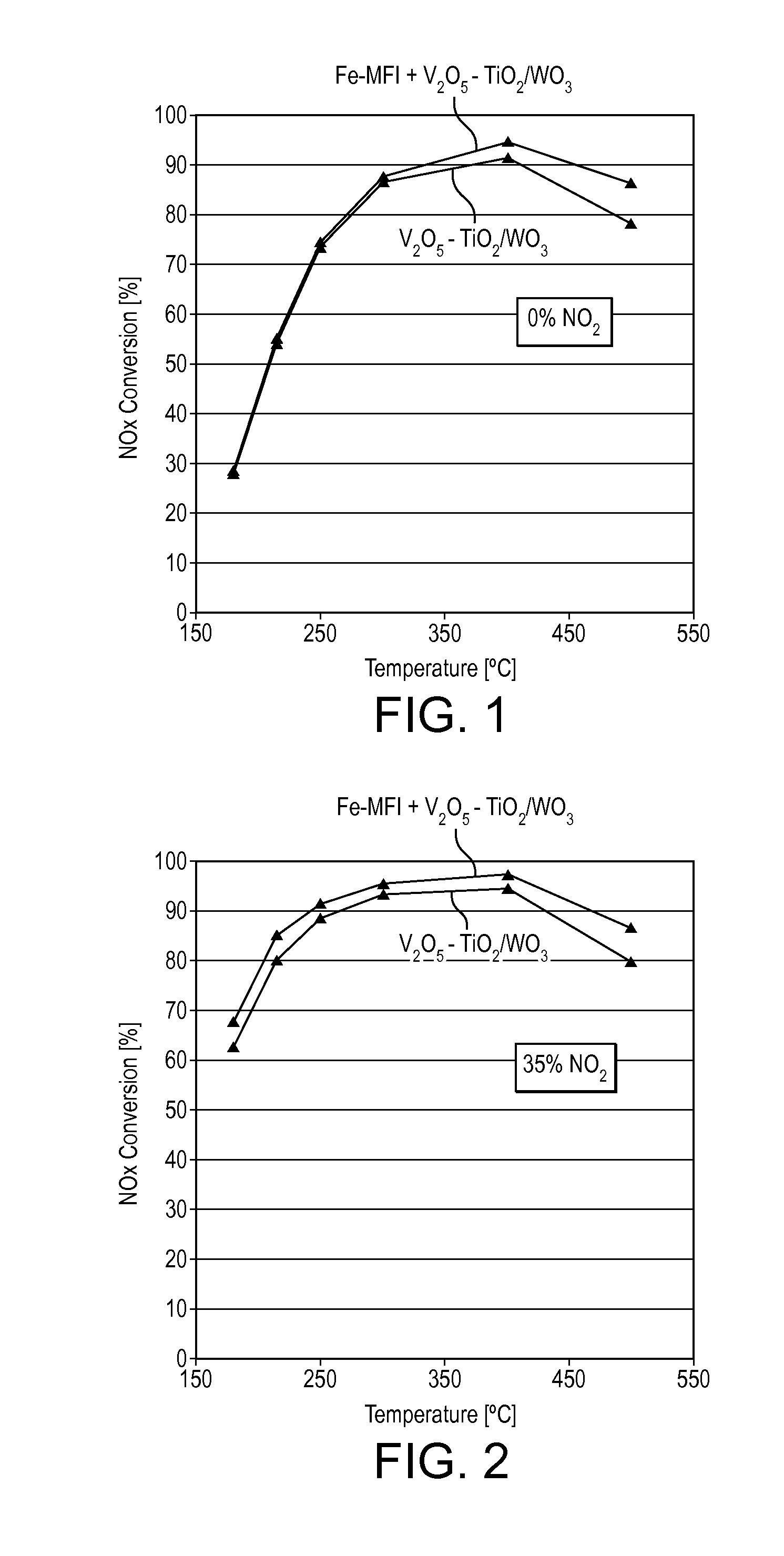ZEOLITE PROMOTED V/TiW CATALYSTS
a technology of zeolite and catalyst, which is applied in the field of catalysts, can solve the problems of reducing the number of no to n/sub>2 in the lean burn exhaust gas, particularly problematic, and the engine, so as to improve the catalytic performance, improve the hydrothermal stability, and improve the effect of high temperature performan
- Summary
- Abstract
- Description
- Claims
- Application Information
AI Technical Summary
Benefits of technology
Problems solved by technology
Method used
Image
Examples
example 1
Preparation
[0050]A catalyst composition was prepared by blending iron exchanged MFI aluminosilicate with a V2O5—TiO2 / WO3 suspension. The resulting composition contained about 20 weight percent iron exchanged MFI aluminosilicate based on the combined weight of the iron exchanged MFI aluminosilicate and V2O5—TiO2 / WO3 solids. A similar process was followed to prepare a catalyst containing 5 weight percent iron exchanged MFI aluminosilicate; a catalyst containing 20 weight percent iron exchanged FER aluminosilicate; a catalyst containing 5 weight percent iron exchanged FER aluminosilicate; a catalyst containing 20 weight percent a BEA ferrosilicate; and a catalyst containing 10 weight percent a BEA ferrosilicate.
[0051]These catalysts blends were formed into an extrudable mass, kneaded, strained, and then extruded to form 1 inch diameter×140 mm honeycomb bricks.
[0052]Additionally, catalyst material containing 20 weight percent iron exchanged MFI aluminosilicate was formed into an extruda...
example 3
Performance (Post-Hydrothermal Aging)
[0057]An extruded 1 inch diameter×140 mm honeycomb fresh brick containing a blend of iron exchanged MFI aluminosilicate and V2O5—TiO2 / WO3 (20 weight percent Fe-MFI), was aged for 100 hours at 580° C. Three additional fresh bricks were also aged, each at one of the following conditions: 100 hours at 580° C. and 10% H2O; 100 hours at 650° C.; and 100 hours at 650° C. and 10% H2O.
[0058]For comparison, two similar catalytic bricks were prepared using only V2O5—TiO2 / WO3. Each of the comparative samples were aged at one of the following conditions: 100 hours at 580° C. and 100 hours at 650° C.
[0059]All of the bricks were exposed to a simulated diesel engine exhaust gas at a space velocity of about 60,000 / hour. The simulated exhaust gas contained about 9.3 wt. % O2, about 7.0 wt. % H2O, about 100 ppm NOx (NO only) about 100 ppm NH3, and the balance N2. The catalyst's capacity for NOx conversion was determined at temperatures of 180, 215, 250, 300, 400, ...
example 4
ve Catalyst Performance
[0061]An extruded 1 inch diameter×140 mm honeycomb brick containing a blend of iron exchanged MFI aluminosilicate and V2O5—TiO2 / WO3 (20 weight percent Fe-MFI), was exposed to a simulated diesel engine exhaust gas at a space velocity of about 60,000 / hour. The simulated exhaust gas contained about 9.3 wt. % O2, about 7.0 wt. % H2O, about 100 ppm NOx (65 weight percent NO2), about 100 ppm NH3, and the balance N2. The catalyst's capacity for NOx conversion was determined at temperatures of 180, 215, 250, 300, 400, and 500° C.
[0062]Another extruded 1 inch diameter×140 mm honeycomb brick, but containing a blend of iron exchanged FER aluminosilicate and V2O5—TiO2 / W3 (20 weight percent Fe-FER), was exposed to a simulated diesel engine exhaust gas at a space velocity of about 60,000 / hour. The simulated exhaust gas contained about 9.3 wt. % O2, about 7.0 wt. % H2O, about 100 ppm NOx (65 weight percent NO2), about 100 ppm NH3, and the balance N2. The catalyst's capacity ...
PUM
| Property | Measurement | Unit |
|---|---|---|
| weight percent | aaaaa | aaaaa |
| weight ratio | aaaaa | aaaaa |
| weight | aaaaa | aaaaa |
Abstract
Description
Claims
Application Information
 Login to View More
Login to View More - R&D
- Intellectual Property
- Life Sciences
- Materials
- Tech Scout
- Unparalleled Data Quality
- Higher Quality Content
- 60% Fewer Hallucinations
Browse by: Latest US Patents, China's latest patents, Technical Efficacy Thesaurus, Application Domain, Technology Topic, Popular Technical Reports.
© 2025 PatSnap. All rights reserved.Legal|Privacy policy|Modern Slavery Act Transparency Statement|Sitemap|About US| Contact US: help@patsnap.com



